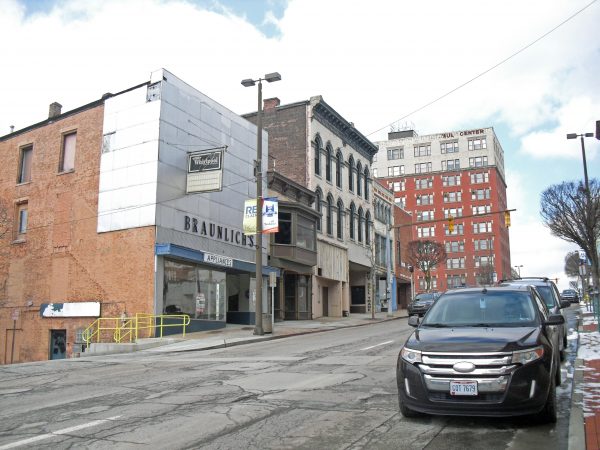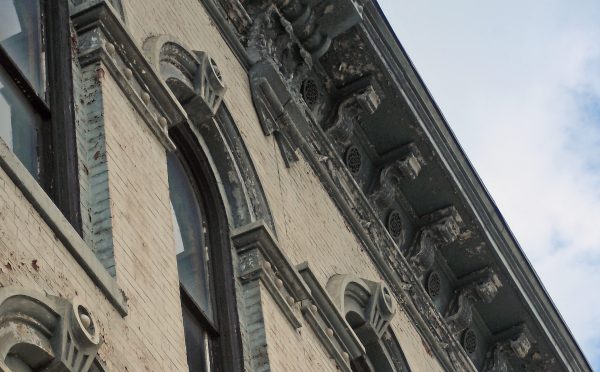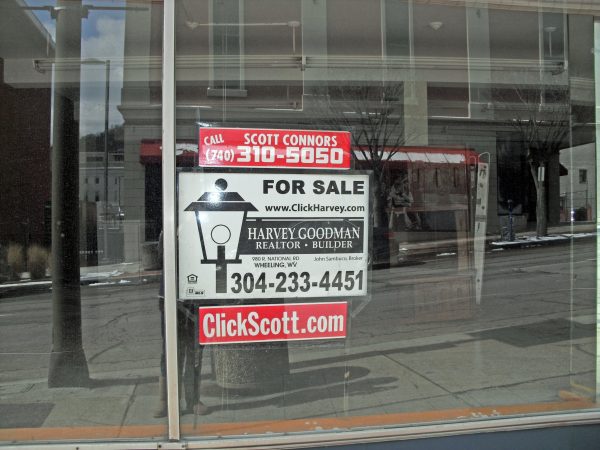But that’s no cause for despair, according to area developers, contractor types and property experts, who say a new boom is afoot.
They say the micro-neighborhood that the newly empty storefronts are in — which is flanked by such catalysts as The Capitol Theatre, the Mull Center, The Health Plan’s corporate offices and a refurbished Stone Center bursting with Williams Lea workers — is so red hot they likely won’t be empty for long.
Here is a closer look at their viewpoints and what new possibilities may be in store for an old downtown:
THE BIG PICTURE
“It’s disappointing to see longtime businesses closing in Wheeling … (But) the city has a great number of entrepreneurs,” according to Valerie Piko, small business coordinator for Regional Economic Development (RED). “One door closes, but it kind of opens up another door.”

Piko is especially encouraged about the possibility of quick redevelopment because of the buildings’ Main Street location.
The neighborhood is already abuzz with big players and critical smaller components are filling in the gaps, she noted. These latter businesses include such developments as the new River’s Edge restaurant, ThrIVe alternative wellness, updates to Bridge Tavern and Grill and the recently opened Mugshots gourmet coffee.
“Those buildings are in a great location, and there’s lots of opportunity there,” Piko said.
Betsy Sweeny, a spokesperson for Wheeling Heritage, said that agency is also excited about the kinds of buildings that house the storefronts. Wheeling Heritage, which owns Weelunk, is chartered by the National Park Service to interpret the city’s history while helping maintain it as a living community.
“We get calls day in and day out, ‘Do you have any downtown storefronts available?’” Sweeny said. “When they were built, they were good for stores and, 100 years later, they still are.”

As that trend has played out in just in the last three to four years, she said it’s become quite difficult to locate the kind of two- to three-story historical buildings that many entrepreneurs want. To have not one, but two such storefronts — and ones that don’t require extensive redevelopment — open at the same time has people talking.
“It’s a fun time to imagine what could be there,” Sweeny said. “We know we have a really robust entrepreneur population that is hungry for storefronts.”
Sweeny qualified that robustness by noting it will take more than entrepreneurs to polish up remaining small facets of the downtown do-over.
“I think we have this impression that entrepreneurs are also developers,” Sweeny said. “But, that’s really an outrageous thing to think that the guy that wants to open the taco bar and invest all his savings and energy in that is also a general contractor and knows how to use tax credits for redevelopment. … Sometimes, we need the developer to come in first, so that taco shop guy has a place to put his tacos.”
She is also looking at some of the larger spaces in the upper Main Street micro-neighborhood that could lend themselves to other types of development. Sweeny especially sees the possibility for a large venue business that could host weddings and similar events.
STOREFRONT SPECIFICS
While two storefronts have opened up with the closures of Braunlich’s and the Outdoor Store, there are technically three buildings in play, according to agents with Harvey Goodman Realtor, which is listing the properties.
The former Outdoor Store — which offered everything from a pawn shop to military surplus to outdoor supplies over the last 35 years — is actually two buildings. The circa 1900 duo — 1065 and 1067 Main St. — is listed jointly at $225,000, according to listing agent Sam Matheny.

“On Main Street, they are probably the last two historic buildings that are in really good condition,” Matheny said of why the buildings are in private redevelopment rather than needing the city to step in with incentives including a nominal purchase price. “They’re not selling for a buck because you’re not going to have to bring them back.”
He ticked off improvements to the Outdoor Store side of the property such as fresh wiring, plumbing and a reroofing that make it effectively move-in ready. “The structure, it is phenomenal. It’s been kept up.”
The empty south side of the property, which was once a bar called Big Bertha’s, needs some work, he noted. But Matheny said the access to the redone utilities just next door is available from sub-basements. Upstairs, second and third floors on the buildings could make four very large apartments or more smaller units, he said, although those floors will need work such as replastering and rewiring.
“There’s been interest as a restaurant,” Matheny said of early contacts on the property, which he noted has a view of the Ohio River from back windows.
Another plus is architectural detailing, he added. Cornice work on the roofline is intact, as are arched windows that still have wavy glass. “Lots of the original wood is in there,” as well, Matheny said.
A fun fact, the Outdoor Store side of the property has four sub-basements. He has heard that train tracks used to run up against the back of the property in a way that allowed unloading directly into the building.

Gabe Hays, a landscape architect who is developing the building that houses Mugshots gourmet coffee just down Main Street, said he had heard that unloading included the city’s Civil War dead. It is believed one of the sub-basements was a temporary morgue for soldiers until they could be claimed by their families.
That kind of history is more than a fun fact, Matheny noted. Like the rest of downtown and much of the city, building redevelopers can tap into the generous federal and state historic redevelopment tax credits mentioned by Sweeny of Wheeling Heritage.
The other building, the former Braunlich’s, is located at 1073 Main St. and is listed at $124,900, according to agent Scott Connors, also with Harvey Goodman Realtor.
“It’s been in the same family since about 1950,” Connors said, noting the store is closing because the owners are retiring. With the recent closure and resale of Berry Supply Store on Water Street, he believes Braunlich’s was the oldest continuously operating store in the downtown.
There’s the history, but there’s also the possibility, Connors noted. “It’s really interesting how the old-time businesses are making way for new opportunities … We’ve had interest in it from the time it was listed. We think it’s going to sell, and that the whole area is going to be revitalized.”
Indeed, a building in between the two available properties is already in redevelopment as a storefront and residence by Adventures in Elegance, he added.
THE NITTY GRITTY
Gabe Hays, the landscape architect who is also redeveloping property in the same block of Main Street, agreed with all of the above as to the trending of the micro-neighborhood. His storefront at 1109 Main St. opened this week as Mugshots gourmet coffee at street level.

“It is (a hot location),” Hays said. “I perceived it for a much longer period of time (than just after Health Plan went in.)”
His Zane Building actually caught his attention in the early aughts, while he was overseeing the landscaping project for Heritage Port. Development attention at the time was focused around WesBanco Arena, he said, but standing in Heritage Port, he looked north toward the bluff that was once home to Fort Henry and was hooked.
“I fell in love with the buildings of 1109, 1107 and 1111,” said Hays, who is co-developing his property with the owners of 1107 and 1111, including constructing a shared fire escape. “I thought, ‘How cool!’ I wish somebody would do something. And, 15 years later, I became that somebody.”
Hays has done other redevelopments, including the St. Clairsville building that houses his design studio, but this was his first building re-do in downtown Wheeling. He purchased the location, which needed extensive work, from the city.
Not to say he hasn’t been involved in other elements of the downtown revitalization. In addition to Heritage Port, he did landscape designs for The Health Plan, Market Plaza and a pocket park at 11th and Main streets. He is also the principal behind a downtown streetscape project that is in the design phase.

“It’s going to change the face of the city,” he said of a streetscape plan that will sweep the downtown and is anticipated to involve both public and private funds.
Hays sees the streetscape effort as icing on a development cake that is already far into the baking — and as a chance to revisit the micro-neighborhood’s deep roots.
Already, he has incorporated faux bois pavers that outline the approximate location of the blockhouse to which Betty Zane made her historic dash for gunpowder into the 11th Street pocket park. It is a counterpoint to a similar marker in front of the River’s Edge restaurant that outlines the approximate location of Fort Henry itself.
He wants to somehow incorporate Zane-like footprints between the two locations for an extra dash of authenticity.

The streetscape may add some extra development zip to the micro-neighborhood in another, more modern way, he noted.
“There’s a concern in Wheeling for safety … people tend to travel faster on routes that are super wide.” New sidewalks planned in the streetscape, which will have gentler slopes for disability compliance, will also include native trees and planters that come out to the edge of the road. Hays said this will visually reduce the width of the roadway to slow drivers down.
Plantings will also include “bioswales” to help with storm-water runoff.
“It will be a more beautiful, modern looking, park-like downtown,” he said of the anticipated completion of this new boom in the heart of an old city. “(It’s about) hopeful people like me who believe in Wheeling to come back.”
• A long-time journalist, Nora Edinger also blogs at noraedinger.com and Facebook and writes books. Her Christian chick lit and faith-related non-fiction are available on Amazon. She lives in Wheeling, where she is part of a three-generation, two-species household.


